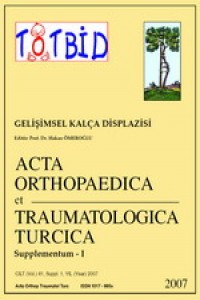Öz
Gelişimsel kalça displazisinin medialden açık yerleştirme ile tedavisi ilk yaşlarda sık uygulanan, etkin cerrahi yöntemlerden biridir. Değişik yaklaşım, tespit ve izleme yöntemleri önerilmekle birlikte, posteromedial girişimle ve artrografiden de yararlanılarak uygulanacak algoritma ile oldukça başarılı sonuçlar elde edilebilmektedir. Medial girişimle yapılan açık yerleştirmenin amacı, displastik kalçada Tönnis I. derece artrografik yerleştirmeyi elde edip devamlılığı sağlamak olmalıdır. Bu yöntemle tedavide görülebilecek sorunlardan biri femur başı avasküler nekrozudur. Bu sorunun gerçek değerlendirilmesi olguların erişkin döneme kadar izlenmesini gerektirse de, sorunun önlenmesinde etkili olan unsurlara (sınırlı girişimsel cerrahi, uygun yerleştirme ve uygun konumda tespit) dikkat edilmesi şarttır.
Anahtar Kelimeler
Öz
Open reduction of developmental hip dysplasia by the medial approach is one of the effective surgical treatment methods during early childhood. Although surgical approaches, fixation and follow-up methods may vary, successful results can be obtained by the algorithm involving the posteromedial approach and arthrographic evaluation. The aim of open reduction by the medial approach should be to obtain Tönnis grade I arthrographic reduction of the dysplastic hip and to maintain it. Avascular necrosis of the femoral head is a potential complication of this method. Even though actual evaluation of this problem requires monitoring patients until maturity, it is essential that special attention be given to the most effective factors (minimal invasive surgical technique, correct reduction, and appropriate position for fixation) for preventing this complication.
Ayrıntılar
| Birincil Dil | İngilizce |
|---|---|
| Konular | Sağlık Kurumları Yönetimi |
| Bölüm | Derleme |
| Yazarlar | |
| Yayımlanma Tarihi | 18 Nisan 2007 |
| Yayımlandığı Sayı | Yıl 2007 Cilt: 41 |


